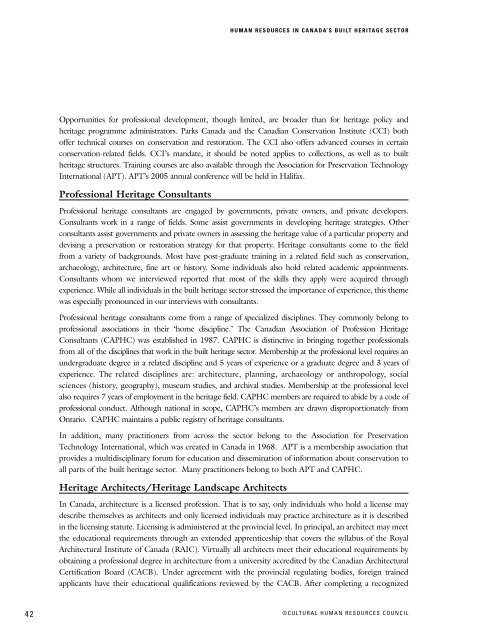Human Resources in Canada's Built Heritage Sector: Mapping the ...
Human Resources in Canada's Built Heritage Sector: Mapping the ...
Human Resources in Canada's Built Heritage Sector: Mapping the ...
- No tags were found...
Create successful ePaper yourself
Turn your PDF publications into a flip-book with our unique Google optimized e-Paper software.
HUMAN RESOURCES IN CANADA’S BUILT HERITAGE SECTOROpportunities for professional development, though limited, are broader than for heritage policy andheritage programme adm<strong>in</strong>istrators. Parks Canada and <strong>the</strong> Canadian Conservation Institute (CCI) bothoffer technical courses on conservation and restoration. The CCI also offers advanced courses <strong>in</strong> certa<strong>in</strong>conservation-related fields. CCI’s mandate, it should be noted applies to collections, as well as to buil<strong>the</strong>ritage structures. Tra<strong>in</strong><strong>in</strong>g courses are also available through <strong>the</strong> Association for Preservation TechnologyInternational (APT). APT’s 2005 annual conference will be held <strong>in</strong> Halifax.Professional <strong>Heritage</strong> ConsultantsProfessional heritage consultants are engaged by governments, private owners, and private developers.Consultants work <strong>in</strong> a range of fields. Some assist governments <strong>in</strong> develop<strong>in</strong>g heritage strategies. O<strong>the</strong>rconsultants assist governments and private owners <strong>in</strong> assess<strong>in</strong>g <strong>the</strong> heritage value of a particular property anddevis<strong>in</strong>g a preservation or restoration strategy for that property. <strong>Heritage</strong> consultants come to <strong>the</strong> fieldfrom a variety of backgrounds. Most have post-graduate tra<strong>in</strong><strong>in</strong>g <strong>in</strong> a related field such as conservation,archaeology, architecture, f<strong>in</strong>e art or history. Some <strong>in</strong>dividuals also hold related academic appo<strong>in</strong>tments.Consultants whom we <strong>in</strong>terviewed reported that most of <strong>the</strong> skills <strong>the</strong>y apply were acquired throughexperience. While all <strong>in</strong>dividuals <strong>in</strong> <strong>the</strong> built heritage sector stressed <strong>the</strong> importance of experience, this <strong>the</strong>mewas especially pronounced <strong>in</strong> our <strong>in</strong>terviews with consultants.Professional heritage consultants come from a range of specialized discipl<strong>in</strong>es. They commonly belong toprofessional associations <strong>in</strong> <strong>the</strong>ir ‘home discipl<strong>in</strong>e.’ The Canadian Association of Profession <strong>Heritage</strong>Consultants (CAPHC) was established <strong>in</strong> 1987. CAPHC is dist<strong>in</strong>ctive <strong>in</strong> br<strong>in</strong>g<strong>in</strong>g toge<strong>the</strong>r professionalsfrom all of <strong>the</strong> discipl<strong>in</strong>es that work <strong>in</strong> <strong>the</strong> built heritage sector. Membership at <strong>the</strong> professional level requires anundergraduate degree <strong>in</strong> a related discipl<strong>in</strong>e and 5 years of experience or a graduate degree and 3 years ofexperience. The related discipl<strong>in</strong>es are: architecture, plann<strong>in</strong>g, archaeology or anthropology, socialsciences (history, geography), museum studies, and archival studies. Membership at <strong>the</strong> professional levelalso requires 7 years of employment <strong>in</strong> <strong>the</strong> heritage field. CAPHC members are required to abide by a code ofprofessional conduct. Although national <strong>in</strong> scope, CAPHC’s members are drawn disproportionately fromOntario. CAPHC ma<strong>in</strong>ta<strong>in</strong>s a public registry of heritage consultants.In addition, many practitioners from across <strong>the</strong> sector belong to <strong>the</strong> Association for PreservationTechnology International, which was created <strong>in</strong> Canada <strong>in</strong> 1968. APT is a membership association thatprovides a multidiscipl<strong>in</strong>ary forum for education and dissem<strong>in</strong>ation of <strong>in</strong>formation about conservation toall parts of <strong>the</strong> built heritage sector. Many practitioners belong to both APT and CAPHC.<strong>Heritage</strong> Architects/<strong>Heritage</strong> Landscape ArchitectsIn Canada, architecture is a licensed profession. That is to say, only <strong>in</strong>dividuals who hold a license maydescribe <strong>the</strong>mselves as architects and only licensed <strong>in</strong>dividuals may practice architecture as it is described<strong>in</strong> <strong>the</strong> licens<strong>in</strong>g statute. Licens<strong>in</strong>g is adm<strong>in</strong>istered at <strong>the</strong> prov<strong>in</strong>cial level. In pr<strong>in</strong>cipal, an architect may meet<strong>the</strong> educational requirements through an extended apprenticeship that covers <strong>the</strong> syllabus of <strong>the</strong> RoyalArchitectural Institute of Canada (RAIC). Virtually all architects meet <strong>the</strong>ir educational requirements byobta<strong>in</strong><strong>in</strong>g a professional degree <strong>in</strong> architecture from a university accredited by <strong>the</strong> Canadian ArchitecturalCertification Board (CACB). Under agreement with <strong>the</strong> prov<strong>in</strong>cial regulat<strong>in</strong>g bodies, foreign tra<strong>in</strong>edapplicants have <strong>the</strong>ir educational qualifications reviewed by <strong>the</strong> CACB. After complet<strong>in</strong>g a recognized42©CULTURAL HUMAN RESOURCES COUNCIL










